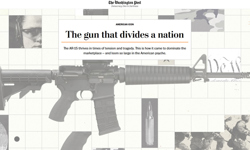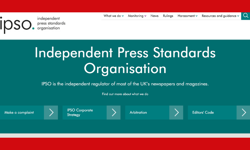The business cards of a not insignificant proportion of the 45,000 people currently working in regional press will carry the description ‘Newspaper Sales’ or ‘Circulation’… but what exactly does this mean? In the increasingly complex environment that is information delivery and consumption in the 21st century, what is expected of these poor (and potentially confused) souls?
Is it their job to increase sales (or at least arrest the decline trend) of good old-fashioned newsprint and ink products? Perhaps they should be working alongside their advertisement sales colleagues to specify and deliver audience of a size and profile to ensure that clients generate an acceptable return from their advertising investment in our growing portfolio of products? Or what about optimising revenues from cover price? (Go on. I dare you. Ask your boss for a definitive answer. Do it today. Answers - printable only - on postcards to the editor…)
We could, of course, sit on the fence and glibly answer "all of the above, of course", but therein lies a key dilemma. In isolation each of the three choices would demand very different strategies. However these would be crystal clear and in many ways easier to deliver and measure than the combination approach which, in the absence of clarity, dominates almost by default.
Put simply, regional publishers are - by a country mile - the best at gathering and editing packages of news and information that are of interest and assistance to people living their lives in that locality. It is the dissemination of this which is starting to change, reflecting differing consumer priorities, lifestyles and the growing number of new channels carrying the data that was previously the exclusive domain of good old newspapers.
Given this context it’s perhaps not surprising, then, that the industry has a complex and multi-faceted way of measuring and promoting its results. Twice a year, in March and September, we brace ourselves for the concurrent release of ABC data. A unitary currency for measuring the number of copies sold on an ‘average day’ by newspapers during the last six months. (Our national colleagues do this monthly and regional dailies have this option. Weeklies can choose to report annually.)
Behind the headlines lies a labyrinth of combinations and calculations covering such matters as ‘actively purchased’, full price (or not), exclusions, Monday-Friday, Monday-Saturday, Saturday only, issue specific and regular bulk sales.
I could go on. And on.
ABC
An all-powerful council supported by the hands-on working party and made up of a combination of publishers and advertisers debate regular rule updates designed to clarify matters for …… who exactly? All this effort could be seen to raise more questions than answers. The main one of which is "why are we asking our advertisers to buy space based on the number of copies sold or distributed"? Not for the first time we ask if broadcast media sales people sit in front of clients discussing the number of television or radio sets in existence across the country. Hmmm, perhaps not. And utterly useless if the damned things are rarely or never switched on. (We would say that, wouldn’t we!)
This dominates a lot of our thinking and ABC does an increasingly good job of doing what it does, but doesn’t all this constitute something of a complex distraction if we accept that our future lies in a multi-media approach to reaching consumers and presenting advertiser propositions? Free daily titles distributed to commuters, web-based summaries of newspaper content, on-line pdf versions of our printed products, niche interest magazines, direct marketing capability arising from more skilful treatment of data and other approaches all achieve the goal of maximising audience reach. In these circumstances, cover price revenues are becoming relegated to the status of only ‘quite important’ given that each year the relative contribution to total revenue from advertising continues to increase. We must deliver response in return to justify the 70%+ of our total revenue which now comes from this source - at (almost) any cost.
Fine then. Having established that pairs of eyes, opportunities to see, impacts and likelihood of the reader to respond are the key currency and that this can only be maximised through a variety of media - why continue to beat ourselves up over declining newspaper sales volumes? Shouting about copy sales simply gives sharp advertisers the chance to negotiate around rate increases which they see as a triple-whammy. Increasing prices, declining numbers, growing cost-per-thousand. So readership data is surely the answer.
JICREG
Or is it? Currently, JICREG does its level best to work with a relatively dis-jointed flow of information from those titles that regard the return-on-very-significant-investment of readership research to be worthwhile. Because many don’t, much of the information is modelled, the frequency of update is tri-ennial (that’s right, once every three years in the most dynamic environment any of us have ever experienced) and the questionnaire design allows for collection of data on only paid and free titles (not our developing new channels). Having said all that, it does still provide a fairly compelling case for buying regional press - but only those traditional aspects of it covered by the existing methodology. And the expense of gathering this highly important sales support information often means that the cupboard is bare when it comes to funding more qualitative research into consumer habits and motivations.
Our competitors in radio have managed to organise themselves in a much slicker way, transcending the boundaries of ownership and commerciality (or otherwise) to organise a rolling annual survey providing clear industry-wide data updated and aggressively promoted on a quartely basis. And despite already possessing an element of high ground there is much pressure from within to modernise and seek to move further ahead. It’s not a done deal, but I’m told that Mr McKenzie is a pretty persuasive guy!
And none of this takes account of the true Holy Grail. Just think how massively powerful it would be (for publishers and their commercial customers) to know each consumer of each element of their portfolio mix. Their name, address, mobile telephone number, interests, motivations, methods of information consumption, propensity to purchase specific products and services...
Despite the added complexity of a current supply chain dominated by the retail sector thus creating a third party in the customer interaction, the technology exists to make this the ultimate way of measuring, understanding and promoting our reach and effectiveness. Names AS WELL AS numbers, all for the price of one. But is the will there to really challenge the status quo?
Newspaper Society
It’s difficult to believe that it is now over four years ago that the Newspaper Society formed a working party with the following objectives:
* To enhance and develop current audience measurement tools to improve the service to customers and increase advertising revenues at a local and national level
* To explore and identify the best way in the future of measuring and publicising the audience that regional publishers deliver through a widening portfolio of printed and electronic products
An ‘expert group’ was assembled, carefully selected to bring ‘gravitas, experience and bold thinking’ to the topic (and I was included too!). All stakeholder groups were represented and/or given the opportunity to input to the process. Forty hours of discussion confirmed that advertisers and agencies wanted: actual (not modelled) data; a system more comparable to other media; flexibility; more regularity and up-to-date results and ability to plan at a macro and micro level. Publishers were seeking: improved ROI; better reflection of TOTAL audience being delivered; a more equitable system and simpler processes. Pretty straight forward, then!
Despite benchmarks, which revealed that regional press re-invested less in this type of activity than any of its competitors, the group’s recommendations attempted to encompass all of the requirements but did so without increasing current overall industry expenditure. This would have been achieved through a simplification of the process and cutting out one layer of the double and triple counting that currently takes place across ABC, third party audits, JICREG and the research, which populates it.
A test was proposed which sought to confirm that the detail supported the theory, but there the trail stopped. Perhaps the ideas had been too challenging, perhaps they had not been clearly understood, perhaps too many groups with vested interests were made to feel uncomfortable. Maybe the team had simply got it wrong. (The author seeks to attach no blame here, simply to point out that all change is challenging by its nature and perhaps even more effort should have been and still requires to be spent in achieving buy-in across the board.)
Much has flowed under the bridge in the intervening time all of which confirms the validity of the brief and, if anything, the need for change is even greater today due to the acceleration in publishers delivering audiences via multi-channels, than it was in the autumn of 2000.
While this debate continues, what does this mean for our newspaper sales and circulation teams around the country? Should they be asked, Canute-like and in the context of the wider business actively seeking to provide alternative information delivery formats, to simply account for and forecast future declines in the number of our core products we are selling?
Should we allow them carte-blanche (including the necessary funds) to do anything it takes to maintain and increase volumes in isolation from the bigger picture?
What would an MD or commercial director make of his or her newspaper sales manager proudly announcing that 20 home delivered customers had successfully been transferred to its Newsstand-powered electronic on-line version? Not good news for the next ABC but at even 10 pence per day more profitable than having to print the things. The ads have as much chance of being viewed as those in print and click-through options make response more measurable.
Maybe structures and the thought processes behind them will have to adapt and merchandisers and tele-sales operators will morph into audience delivery managers, reader relationship supervisors and content promotion executives.
History and established processes should not be used as excuses for inertia. Our people need to know precisely what is expected of them and have an industry-wide measurement system and single currency, which clarifies and supports this.
FEATURE
Measuring up to expectation?
In today’s multi-media world, where our readers receive content across an ever growing number of platforms, are we measuring the right things? Russell Borthwick urges the regional newspaper sector to invest more time and resource into the quest for a new industry wide measurement system.










